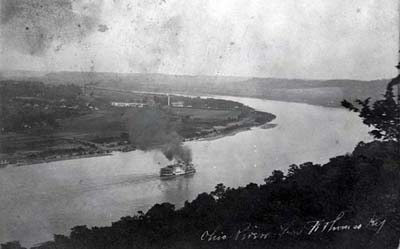Waterborne Entertainment on the Upper Ohio River
By Borgon Tanner

The excursion boat Princess on the Ohio River in about 1915, as seen from Fort Thomas, Kentucky. Photograph courtesy of Murphy Library, University of Wisconsin – LaCrosse.
New Martinsville 75 years ago prospered from farm traffic, a nearby B&O railroad junction and terminal, and river traffic. Summertime for older teens and adults meant the arrival of showboats or the long-awaited excursion boat at the cobblestone wharf along the beautiful Ohio River.
As I recall, at least two showboats arrived each summer but only one excursion boat. I was too young back then to board these unusual vessels, but I remember the arrival of each type. Friends have described the attractions of the showboats, and I learned about the patterns and at least some of the pleasures of the famed excursion boats from an older brother.
Showboats were more numerous and offered entertainment for many in our town. These floating theaters were at the peak of their performance by the “modern” times of the 1930’s.
Showboats relied on a steam-powered towboat to move them from place to place. This arrangement allowed more space to be used and took away the responsibility of maneuvering the bulky vessel on the river and into landings. Towboats also provided steam for another use at each landing.
The special boats had their own way of advertising. The events were always listed in our two weekly papers: the Wetzel Democrat and the Wetzel Republican. Posters were placed in strategic locations around town, but more was to come.
Imagine it’s a hot summer afternoon in the Upper Ohio Valley. A showboat has come upriver and is about to dock near our busy wharf. People from nearby buildings stream down to watch the large boat with its ornate lettering tie up along the bank. That marked its quiet arrival.
The wake-up call would come in late afternoon. That’s when the calliope came alive. The proper pronunciation of this unusual instrument was supposed to be “ku-lie-uh-pee.” We “river people” said it the right way: “kahl-lee-oap.”
Anyway you pronounced it, it was loud – blame loud! The calliope was a steam-powered organ, driven by the coal-fired towboat engine. Soft tones were difficult to produce on it. We lived quite a distance from the river, but we well knew when one of the showboats was making a pitch for evening customers. From our distant location we not only received the full recital but were in a position to hear the “grace notes” as the sounds echoed back from the hills beyond us. Choice seats at these recitals were distant seats. If you were hard of hearing or lived 12 blocks away, you could stay indoors and listen. If you lived on German Ridge on the West Virginia side or atop the hill above Duffy on the Ohio side, the music was great.
Actually the calliope was played with skill. Imagine sitting at a keyboard and pushing down keys that opened valves to let damp steam enter the chambers in the steam organ pipes - hands moving all over the keyboard, live steam emerging from the opening, and thunderous noise combined to produce stirring music.
After the last notes from the calliope had echoed back from the hills there would be a lengthy pause. Then the evening performance would begin on the showboat.
The showboats that graced the river towns provided audiences with drama and melodrama: tragedies, heartaches, and thrills. The types of plays varied little. Some of the most dramatic moments came from the renditions of “Uncle Tom’s Cabin,” or the never-failing “Ten Nights in a Barroom.” Sometimes a slapstick comedy was offered, much to the delight of country folk and a few solid citizens in the audience. Humor was far less sophisticated 75 years ago. Many rustic actions and sounds were considered uproariously funny back then.
One performance a night might provide light entertainment from a singer or two and the abbreviated orchestra. And a few showboats held matinees for youngsters and their parents, usually a puppet or Punch & Judy show.
Showboats on the Upper Ohio commonly had large audiences. Most local boats stopped twice every summer at New Martinsville, going upriver and then, weeks later, coming back downriver, heading south before cooler weather arrived.
The pattern of the excursion boats was quite different. In the operation of the excursion boats, one could truthfully say that the crew worked with the moon and the weather. They worked when the moon was a bit beyond the first quarter through the full moon, and a bit before the end of the third quarter – approximately 20 days a month in the summer season.
And by necessity they operated during dry weather. Rain or dense fog did not produce a romantic setting or a suitable surface on a hardwood floor for dancing.
The excursion boats were self-propelled. There were several advantages in this arrangement.
You can read the rest of this article in this issue of Goldenseal, available in bookstores, libraries or direct from Goldenseal.